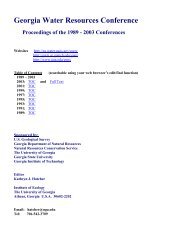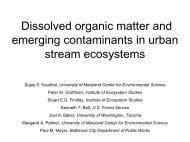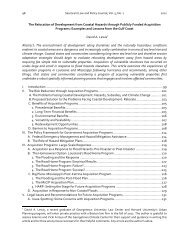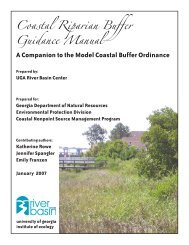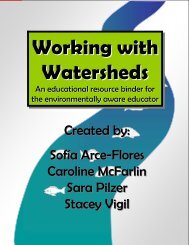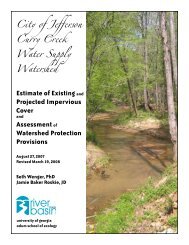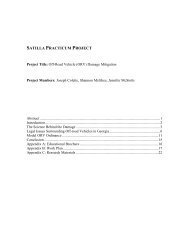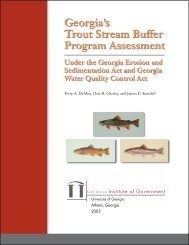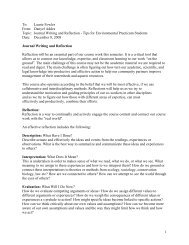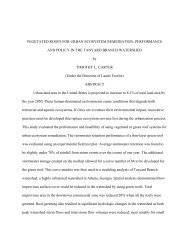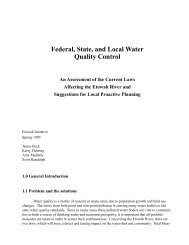The use of constructed wetlands for wastewater treatment
The use of constructed wetlands for wastewater treatment
The use of constructed wetlands for wastewater treatment
You also want an ePaper? Increase the reach of your titles
YUMPU automatically turns print PDFs into web optimized ePapers that Google loves.
12 <strong>The</strong> <strong>use</strong> <strong>of</strong> <strong>constructed</strong> <strong>wetlands</strong> <strong>for</strong> <strong>wastewater</strong> <strong>treatment</strong><br />
sedimentation, adsorption and precipitation at the water-sediment, root-sediment and<br />
plant-water interfaces (Reddy and DeBusk, 1987).<br />
Microbial degradation plays a dominant role in the removal <strong>of</strong> soluble/colloidal<br />
biodegradable organic matter in <strong>wastewater</strong>. Biodegradation occurs when dissolved<br />
organic matter is carried into the bi<strong>of</strong>ilms that attached on submerged plant stems, root<br />
systems and surrounding soil or media by diffusion process. Suspended solids are<br />
removed by filtration and gravitational settlement.<br />
A pollutant may be removed as a result <strong>of</strong> more than one process at work.<br />
Nitrogen removal mechanisms - <strong>The</strong>re are sufficient studies to indicate some roles<br />
being played by wetland plants in Nitrogen removal but the significance <strong>of</strong> plant<br />
uptake vis-à-vis nitrification/denitrification is still being questioned. Nitrogen (N) can<br />
exist in various <strong>for</strong>ms, namely Ammoniacal Nitrogen (NH<br />
3<br />
and NH<br />
4 + ), organic Nitrogen<br />
and oxidised Nitrogen (NO<br />
2 - and NO<br />
3 - ). <strong>The</strong> removal <strong>of</strong> Nitrogen is achieved through<br />
nitrification/denitrification, volatilisation <strong>of</strong> Ammonia (NH<br />
3<br />
) storage in detritus and<br />
sediment, and uptake by wetland plants and storage in plant biomass (Brix, 1993).<br />
A majority <strong>of</strong> Nitrogen removal occurs through either plant uptake or denitrification.<br />
Nitrogen uptake is significant if plants are harvested and biomass is removed from the<br />
system.<br />
At the root-soil interface, atmospheric oxygen diff<strong>use</strong>s into the rhizosphere through<br />
the leaves, stems, rhizomes and roots <strong>of</strong> the wetland plants thus creating an aerobic<br />
layer similar to those that exists in the media-water or media-air interface. Nitrogen<br />
trans<strong>for</strong>mation takes place in the oxidised and reduced layers <strong>of</strong> media, the rootmedia<br />
interface and the below ground portion <strong>of</strong> the emergent plants. Ammonification<br />
takes place where Organic N is mineralised to NH<br />
4 + -N in both oxidised and reduced<br />
layers. <strong>The</strong> oxidised layer and the submerged portions <strong>of</strong> plants are important sites<br />
<strong>for</strong> nitrification in which Ammoniacal Nitrogen (AN) is converted to nitrite N (NO<br />
2<br />
-N)<br />
by the Nitrosomonas bacteria and eventually to nitrate N (NO<br />
3<br />
-N) by the Nitrobacter<br />
bacteria which is either taken up by the plants or diff<strong>use</strong>s into the reduced zone where<br />
it is converted to N<br />
2<br />
and N<br />
2<br />
O by the denitrification process .<br />
Denitrification is the permanent removal <strong>of</strong> Nitrogen from the system, however the<br />
process is limited by a number <strong>of</strong> factors, such as temperature, pH, redox potential,<br />
carbon availability and nitrate availability (Johnston, 1991). <strong>The</strong> annual denitrification<br />
rate <strong>of</strong> a surface-flow wetland could be determined using a Nitrogen mass-balance<br />
approach, accounting <strong>for</strong> measured influx and efflux <strong>of</strong> Nitrogen, measured uptake <strong>of</strong><br />
Nitrogen by plants, and sediment, and estimated volatilisation (Frankenbach and<br />
NH3<br />
Meyer, 1999).<br />
<strong>The</strong> extent <strong>of</strong> Nitrogen removal depends on the design <strong>of</strong> the system and the <strong>for</strong>m<br />
and amount <strong>of</strong> Nitrogen present in the <strong>wastewater</strong>. If influent Nitrogen content is low,<br />
wetland plants will compete directly with nitrifying and denitrifying bacteria <strong>for</strong> NH<br />
4<br />
+<br />
and NO<br />
3 - , while in high Nitrogen content, particularly Ammonia, this will stimulate<br />
nitrifying and denitrifying activity (Good and Patrick, 1987).



